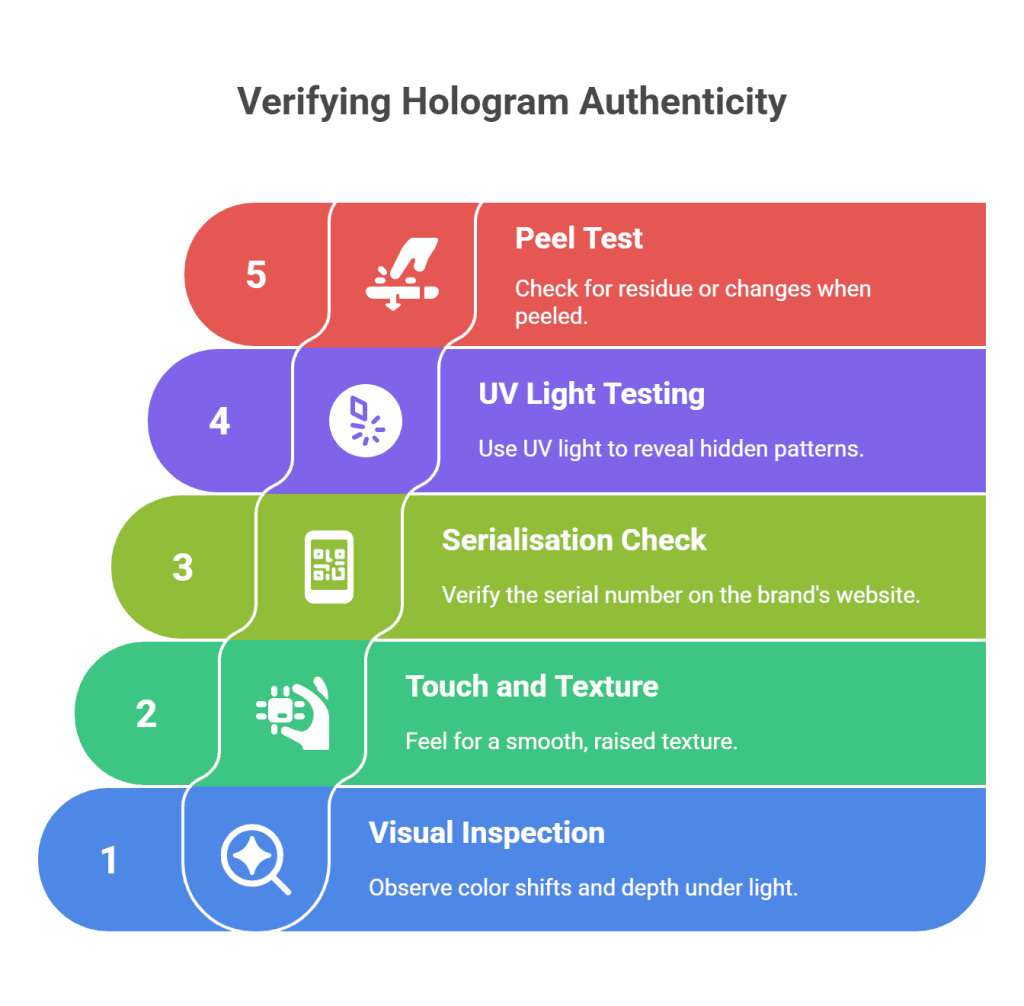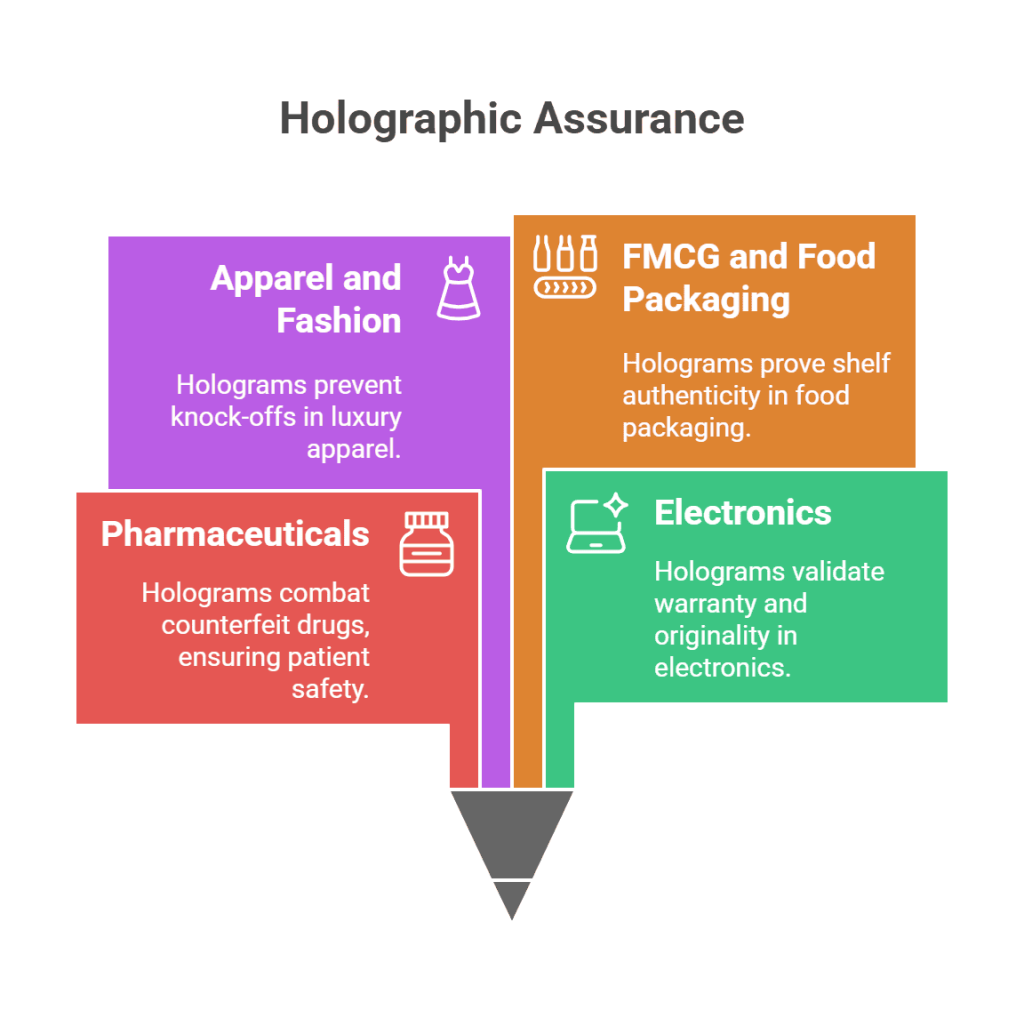In today’s market, authentic hologram stickers play a vital role in brand protection, product verification, and anti-counterfeiting. Whether you’re a business protecting your product line or a consumer trying to verify the genuineness of an item, being able to identify authentic holograms is crucial. But with counterfeiters growing more sophisticated, how do you differentiate between real and fake holograms?

This guide will walk you through the critical signs, security features, and testing techniques used to recognize authentic stickers, backed by industry practices and technological insights.
Why Hologram Stickers Matter
Holograms are no longer mere design elements — they are complex security devices. Used across industries from pharmaceuticals and electronics to FMCG and apparel, authentic hologram stickers serve two primary purposes:
- Brand authentication – proving that a product is genuine and not tampered with.
- Consumer trust – providing a visual cue that builds confidence in the product’s origin.
However, counterfeiters often try to replicate these stickers without the sophisticated technology required to reproduce them accurately.
Key Features of Hologram Authentication Stickers
1. Optically Variable Effects
Most authentic hologram stickers incorporate optically variable devices (OVDs) that display dynamic visual effects when viewed from different angles. These effects cannot be reproduced using standard printing techniques.
Common types include:
- Rainbow diffraction – the spectrum colors change when tilted
- 2D/3D layered depth – multiple image layers at different depths
- Kinetic movement – text or images appear to move when the sticker is rotated
2. Microtext and Nanotext
Authentication hologram stickers often feature micro- or nanotext, which is only visible under magnification. These texts are near-impossible to reproduce without specialized engraving or laser technology.
3. Security Inks
Some sticker application techniques use UV-sensitive or thermochromic inks that change color under UV light or with temperature variation. These are hidden to the naked eye and add an extra layer of verification.
Types of Authentic Hologram Stickers
1. Tamper-Evident Holograms
Once applied, these stickers cannot be removed without leaving a visible mark (like “VOID” text or a shattered pattern). It prevents unauthorised reuse.
2. Serialized Holograms
Each sticker contains a unique serial number, QR code, or barcode that can be verified against a database.
3. Custom Holograms with Brand Logos
Brands often embed their own logos, taglines, or symbols into the holographic design. This is very difficult for counterfeiters to replicate accurately without inside knowledge or access to master tooling.
How to Identify Authentic Hologram Stickers – Original and Authentic

Step 1: Visual Inspection
Hold the product under a light source and tilt it to observe:
- Color-shifting effects
- Depth and motion
- Brand logo clarity
If the sticker looks flat or lacks colour play, it might be fake.
Step 2: Touch and Texture
Genuine holograms often have a specific texture, smooth but slightly raised. A completely flat or paper-like sticker may indicate a counterfeit.
Step 3: Check for Serialization
Scan the QR code or look up the serial number on the brand’s official website. Many companies maintain databases to help customers verify authentic hologram stickers.
Step 4: UV Light Testing
Shine a UV light to reveal hidden text or patterns. Fake holograms usually lack these features.
Step 5: Peel Test (if allowed)
Gently try to peel off the sticker from a sample product. A tamper-evident hologram will leave behind a residue or change its appearance.
Common Mistakes When Checking Holograms
- Assuming all shiny stickers are authentic: Not all holographic-looking stickers have true anti-counterfeiting features.
- Ignoring misspelt words or distorted logos: These are red flags, especially on luxury or pharmaceutical products.
- Relying on appearance alone: Always combine visual inspection with serial number verification when possible.
Industry Use Cases of Hologram Stickers

1. Pharmaceuticals
In India, regulations require certain drugs to carry holograms to combat counterfeit medicines. Authenticity helps save lives. Authentic hologram sticker manufacturers also protect supply chains by ensuring only verified products reach pharmacies and hospitals.
2. Electronics
Top brands like HP, Dell, and Sony use authentic hologram stickers on product boxes and inside laptops to validate warranty and originality. In addition to consumer confidence, these holograms help service centers quickly identify genuine products.
3. Apparel and Fashion
Luxury brands embed serialized holograms on tags to prevent knock-offs in the apparel market. These tags are often paired with NFC chips or blockchain verification for added security. Holographic stickers also play a significant role in the textile industry.
4. FMCG and Food Packaging
From spices to dairy, many packaged food products now use holograms to prove shelf authenticity. This reassures customers about the origin, quality, and safety of their purchases, especially in markets prone to food fraud.
How Businesses Can Protect Themselves
If you’re a brand owner or distributor:
- Work with a certified hologram labels manufacturer with ISO 14298 or IHMA membership.
- Choose custom designs with layered security features.
- Train your supply chain and retail partners to educate consumers on verifying authenticity.
- Deploying authentic hologram stickers not only safeguards your brand but also empowers your consumers.
What Sets Authentic Hologram Stickers Apart?
| Feature | Authentic Stickers | Counterfeit Versions |
| Color Shift | Present(multi-angle) | Often absent |
| Microtext | Crisp under magnification | Usually blurred or missing |
| Serialization | Unique ID, QR, and barcode | Often reused or generic |
| Tamper Evident | Yes | No or easily removed |
| UV Elements | Visible under backlight | Absent |
FAQs: Authentic Hologram Stickers
1. Are all hologram stickers authentic?
No. Many counterfeiters use shiny foils or mimic holograms. Only certified, multi-layered holograms with embedded security features are truly authentic stickers.
2. Can I check the authenticity of a hologram online?
Yes. Many brands provide serial number or QR code verification tools on their websites to verify hologram stickers.
3. What should I do if I suspect a fake hologram?
Report it to the brand directly. Provide photos and serial numbers if available. Brands take counterfeit reporting seriously.
4. Do all products require hologram stickers?
Not always. But for high-value, frequently counterfeited items like electronics, medications, and luxury goods, hologram stickers are highly recommended.
5. Can hologram stickers be reused?
Authentic holograms are usually tamper-evident. Attempting to remove or reuse them will damage the sticker, rendering it invalid.
Conclusion
In a market flooded with lookalikes and fakes, hologram stickers serve as an indispensable line of defense for both brands and consumers. Recognizing them requires a mix of visual awareness, tactile inspection, and digital verification. Whether you’re purchasing high-value goods or overseeing a product line, learning to spot genuine holograms is a small step with a big impact.
Don’t just trust a sticker — verify it. And if you’re a business, make sure your security label is more than just decorative. Invest in authentic hologram stickers that protect your reputation, your product, and your customers’ peace of mind.
For detailed traceability and anti-counterfeit protection, contact Qodenext today.






